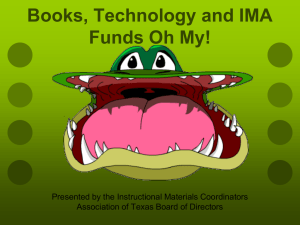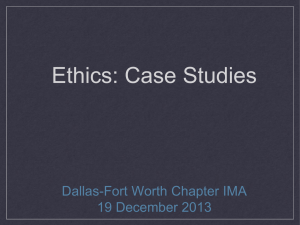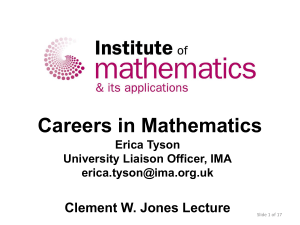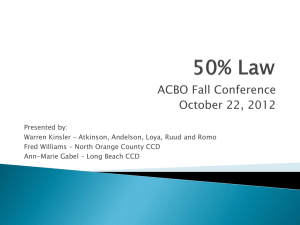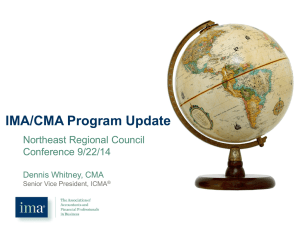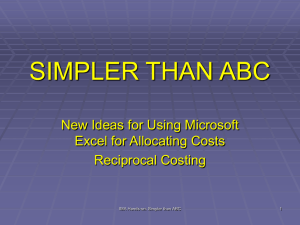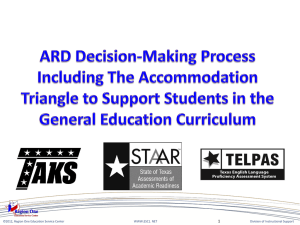Member_Resources_files/Challenges of Change 6-25
advertisement
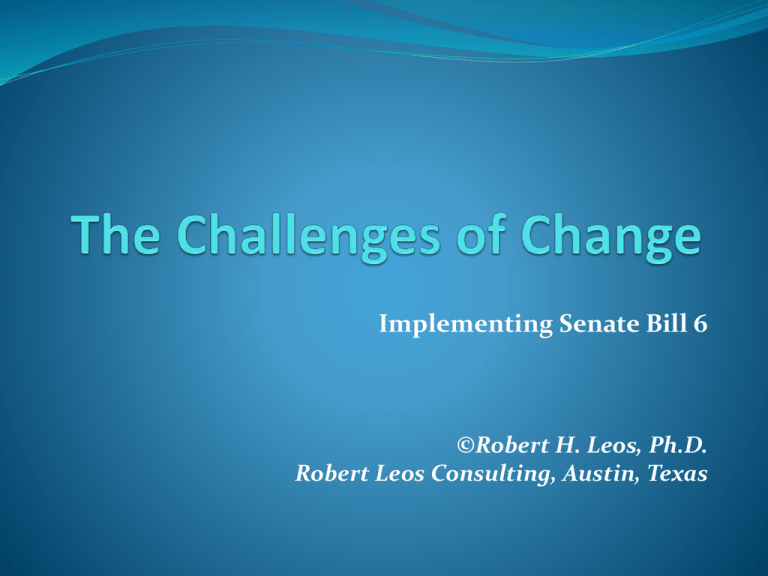
Implementing Senate Bill 6 ©Robert H. Leos, Ph.D. Robert Leos Consulting, Austin, Texas Purpose of the Study To document processes school districts used to plan and implement changes resulting from SB 6. To provide an avenue for textbook coordinators (now instructional materials coordinators) to describe effective planning practices, express concerns, make recommendations for improvement. Study commissioned by the Association of American Publishers with support from the Textbook Coordinators’ Association of Texas (now IMCAT) Pre-SB 6 Era State Textbook Funds The SB 6 Era Instructional Materials Fund (IMF) Technology Allotment (per-ADA) Instructional Materials Allotment (IMA) The Old to the New Pre-SB 6 Era Conforming (100% of TEKS) “textbooks” Nonconforming (50-99% of TEKS) “textbooks” The SB 6 Era One list of adopted “instructional materials” 50% TEKS coverage required for adoption The Old to the New Old to the New Pre-SB 6 Era SB 6 Era State funds generally limited to SBOE-adopted materials Districts now have expanded options for using state IM funds State ownership District ownership Methodology Three focus groups with IM coordinators (Dec. 2011) Transcription and analysis of responses across three focus groups Online survey with IM coordinators (N = 109) Report: “Challenges of Change: Implementing Senate Bill 6.” Available at www.texascurriculum.org Focus Group and Survey Topics How aware were textbook coordinators of proposed changes during and after the legislative session? What were the primary sources of information? How did school districts disseminate information about SB 6 to staff in order to begin the planning processes? Was the information from the Texas Education Agency (TEA) and other sources about SB 6 beneficial? Focus Group and Survey Topics Who were the stakeholders involved in planning expenditures from the IMA? Were there any difficulties with the requisitions and disbursement processes? To what extent did STAAR influence the school districts’ decisions related to expenditures from the IMA? Study Topics (continued) Will school districts spend all of their 2011-12 Instructional Materials Allotments? Other issues, concerns, and recommendations (focus groups and survey). Descriptions of planning and implementation practices (survey respondents). Findings What did we learn? A Major Change In years past, we ordered so much because we could. When they said, “It’s your money now,” we said, “Whoa!” Now, we consider how we used the materials in prior years and whether we will need them in the future. Focus Group Participant Knowledge of SB 6 • 74% of survey respondents indicated that they had a basic understanding of the new legislation when the school year 2011-12 began. • 15% had a thorough understanding of SB 6 and were prepared for implementation when the 2011-12 school year began. • Only about 10% of respondents did not understand the IMA when the school year began. Information Sources Survey Question: What were the information sources that helped you learn about SB 6? TCAT 39.4% TEA 30.0% ESCs 13.1% School administrators 8.0% Media (radio, web, etc.) 5.2% Other 4.3% How did school districts disseminate information about SB 6? Meetings with Principals Meetings with dept. leaders 32.2% 32.2% Staff meetings No information disseminated 19.1% 10.9% Within-district Communication Survey Question: How helpful was the information you received from your administration about SB 6? I have not received information from my administration. 26.6% It has been very helpful. 22.9% It has been somewhat helpful. 34.8% It has not been helpful. 12.8% Excerpt from “Challenges” A superintendent from a school district represented in Group 3 began actively informing staff about the proposed changes using the district’s website, email, and school district newsletter. Excerpt from “Challenges” The second superintendent was very “proactive” during the legislative session, having taken several trips to Austin to speak with legislators about funding. Excerpt from “Challenges” A participant from Group 2 and another from Group 3 described how their superintendents took an active role in monitoring the legislative session and keeping staff informed. One superintendent posted comments on the district’s website about legislative activity. Attitudes about TETN Sessions They were somewhat helpful. 46.7% They were very helpful. 42.2% The TETNs were very beneficial. That is how our central office staff, superintendent, and everyone learned. Focus Group Participant Quality of Information From TEA and Other Sources Generally, all survey and focus group participants were positive about the information that TEA and TCAT provided within a limited amount of time. TCAT played a prominent role in disseminating information about impending legislation. Following passage of SB 6, TEA issued guidelines encouraging school districts to use a team approach to planning for expenditures from the IMA. Team Approach to Planning Business office IM Coordinator Supt. Office Curriculum Principals Technology Teachers Team Approach to Planning (TEA) Business office IM Coordinator Supt. office Curriculum Principals Teachers Technology IMA Expenditures • 60% indicated that their school districts would have a balance in their IMA accounts at the end of the 2011-12 school year. • 25% expect a fund balance at the end of the 2012-2013 school year. • 70% used, or expect to use, their IMA to buy software and technological equipment. Influence of STAAR on IMA Expenditures STAAR did not influence our decisions. STAAR was a minor factor in our decisions. STAAR was a major factor in our decisions. 4.5% 21.1% 48.6% Requisitions and Disbursements • Very few problems with the requisitions process. • Most problems were with the new disbursement process. • Survey included space for recommendations. Effective Planning and Implementation Practices • Use an IMA team or IMA Oversight Committee (IMAOC) for planning expenditures. • Hold regular meetings to make decisions and review proposals submitted. • Use a checklist for proper completion of the disbursement requests. Recommendations • Develop a process to exchange, sell, or donate surplus instructional materials and out-ofadoption materials. • Develop training materials, decision-making models and clear guidelines. • Develop clear definitions, policies, and rules that spell out eligible and non-eligible IMA expenditures. Limitations of the IMA for Small Districts “A participant expressed frustration that small districts would most likely continue using traditional textbooks because of the cost of purchasing and maintaining electronic devices.” Excerpt from The Challenges of Change Observations The role of the textbook (instructional materials) coordinator has expanded greatly. Planning for expenditures from the IMA is critical. Stakeholder involvement in planning ranged from involvement of all key players to limited involvement by two or three. Observations The Instructional Materials Coordinators’ Association of Texas (IMCAT) plays a very important role in disseminating information and training coordinators. Very few parents were involved in planning for instructional materials and technology. More Observations More stakeholders are involved in planning expenditures for instructional materials and other eligible purchases using the IMA. And . . . More Observations TEKS coverage in non-adopted instructional materials will become an important issue. And . . . MORE FLEXIBILITY = MORE ACCOUNTABILITY RESOURCES Full Report is at www.texascurriculum.org. SBOE Rules: TEA website, “Education Laws and Rules.” Commissioner’s Rules: TEA website, “Education Laws and Rules (not final).” TASB Training, August 10, 2012. Registration www.instructional.tasb.org. TEA website: www.tea.state.tx.us. robertleos@austin.rr.com (512) 914-5998 Telephone (512) 892-1781 Fax www.robertleos.com Questions? I think school districts have a greater appreciation for textbook coordinators—what we do and how we do it. Focus Group Participant
